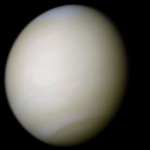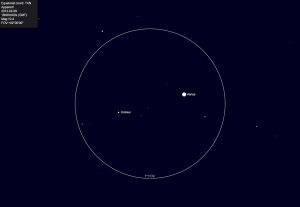When this happens it is called a conjunction. Sometimes the planets will be several degrees apart in the sky but this particular conjunction is a very close one and Uranus will be less than a degree from Venus.
Uranus is theoretically visible to the unaided eye from a very dark site but at magnitude 5.6 it’s right on the limit of what normal people can see. It is easily visible in binoculars though and you should be able to see it close to Venus on this evening.
The chart below shows what it will look like through a telescope with an eyepiece giving 1 degree field of view (FOV). You can calculate your FOV using this simple calculation…
Actual FOV (deg) = Apparent FOV (deg) / (Scope Focal Length (mm) / Eyepiece Focal Length (mm))
For example a 26mm Meade Plössl eyepiece with apparent field of view of 60 degrees in a telescope of focal length 800mm gives…
Actual FOV = 60 / (800 / 26 ) = 1.95 degrees
Nb. eyepieces are sometimes labelled with their apparent FOV or you can usually look it up on the manufacturer’s website.
In a telescope Uranus appears as a greenish blob, distinctly unlike a star. Venus will show a smallish but very bright gibbous disk. It won’t be hard to know where to point your binoculars or telescope as Venus cannot be missed, it will be by far the brightest point of light visible in the southwestern sky as darkness falls.
The chart shows a normal orientation, depending on your telescope the actual view you see may be a mirror-image of this and/or upside-down!


